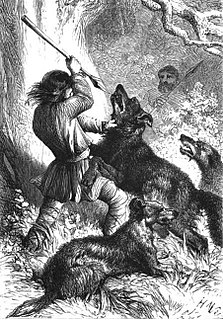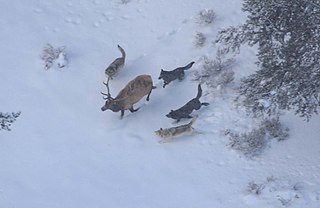
The coyote is a species of canine native to North America. It is smaller than its close relative, the wolf, and slightly smaller than the closely related eastern wolf and red wolf. It fills much of the same ecological niche as the golden jackal does in Eurasia. The coyote is larger and more predatory and was once referred to as the American jackal by a behavioral ecologist. Other historical names for the species include the prairie wolf and the brush wolf.

Canidae is a biological family of dog-like carnivorans, colloquially referred to as dogs and constitutes a clade. A member of this family is also called a canid. There are three subfamilies found within the canid family, which are the extinct Borophaginae and Hesperocyoninae, and the extant Caninae. The Caninae are known as canines, and include domestic dogs, wolves, foxes, coyotes and other extant and extinct species.

The wolf, also known as the gray wolf or grey wolf, is a large canine native to Eurasia and North America. More than thirty subspecies of Canis lupus have been recognized, and gray wolves, as colloquially understood, comprise non-domestic/feral subspecies. The wolf is the largest extant member of the family Canidae, males averaging 40 kg (88 lb) and females 37 kg (82 lb). Wolves measure 105–160 cm (41–63 in) in length and 80–85 cm (31–33 in) at shoulder height. The wolf is also distinguished from other Canis species by its less pointed ears and muzzle, as well as a shorter torso and a longer tail. The wolf is nonetheless related closely enough to smaller Canis species, such as the coyote and the golden jackal, to produce fertile hybrids with them. The banded fur of a wolf is usually mottled white, brown, gray, and black, although subspecies in the arctic region may be nearly all white.

Urination is the release of urine from the urinary bladder through the urethra to the outside of the body. It is the urinary system's form of excretion. It is also known medically as micturition, voiding, uresis, or, rarely, emiction, and known colloquially by various names including peeing, weeing, and pissing.

The maned wolf is a large canine of South America. Its markings resemble those of foxes, but it is neither a fox nor a wolf. It is the only species in the genus Chrysocyon.

Canis is a genus of the Caninae which includes multiple extant species, such as wolves, dogs, coyotes, and golden jackals. Species of this genus are distinguished by their moderate to large size, their massive, well-developed skulls and dentition, long legs, and comparatively short ears and tails.

In ethology, territory is the sociographical area that an animal consistently defends against conspecific competition using agonistic behaviors or real physical aggression. Animals that actively defend territories in this way are referred to as being territorial or displaying territorialism.

A wolfdog is a canine produced by the mating of a dog with a gray wolf, eastern wolf, red wolf, or Ethiopian wolf to produce a hybrid.

The Ethiopian wolf, also known as the Simien jackal or Simien fox, is a canine native to the Ethiopian Highlands. In southeastern Ethiopia it is also known as the horse jackal. It is similar to the coyote in size and build, and is distinguished by its long and narrow skull, and its red and white fur. Unlike most large canids, which are widespread, generalist feeders, the Ethiopian wolf is a highly specialised feeder of Afroalpine rodents with very specific habitat requirements. It is one of the world's rarest canids, and Africa's most endangered carnivore.

The golden jackal is a wolf-like canid that is native to Southeast Europe, Southwest Asia, South Asia, and regions of Southeast Asia. Compared with the Arabian wolf, which is the smallest gray wolf subspecies, the jackal is smaller and possesses shorter legs, a shorter tail, a more elongated torso, a less-prominent forehead, and a narrower and more pointed muzzle. The golden jackal's coat can vary in color from a pale creamy yellow in summer to a dark tawny beige in winter. It is listed as 'least concern' on the IUCN Red List due to its widespread distribution and high density in areas with plenty of available food and optimum shelter.

Pack is a social group of conspecific canines. Not all species of canids form packs; for example, small canids like the red fox do not. Pack size and social behaviour within packs varies across species.

The Eurasian wolf, also known as the common wolf or Middle Russian forest wolf, is a subspecies of grey wolf native to Europe and the forest and steppe zones of the former Soviet Union. It was once widespread throughout Eurasia prior to the Middle Ages. Aside from an extensive paleontological record, Indo-European languages typically have several words for "wolf", thus attesting to the animal's abundance and cultural significance. It was held in high regard in Baltic, Celtic, Slavic, Turkic, ancient Greek, Roman, and Thracian cultures, whilst having an ambivalent reputation in early Germanic cultures.

Dog behavior is the internally coordinated responses of individuals or groups of domestic dogs to internal and external stimuli. It has been shaped by millennia of contact with humans and their lifestyles. As a result of this physical and social evolution, dogs, more than any other species, have acquired the ability to understand and communicate with humans, and they are uniquely attuned in these fellow mammals. Behavioral scientists have uncovered a wide range of social-cognitive abilities in the domestic dog.
Shaun Ellis is an English animal researcher who is notable for living among wolves, and for adopting a pack of abandoned North American timber wolf pups. He is the founder of Wolf Pack Management and is involved in a number of research projects in Poland and at Yellowstone National Park in the United States.

Wolf hunting with dogs is a method of wolf hunting which relies on the use of hunting dogs. While any dog, especially a hound used for hunting wolves may be loosely termed a "wolfhound", several dog breeds have been specifically bred for the purpose, some of which, such as the Irish Wolfhound, have the word in their breed name.

The African wolf is a canine native to North Africa, West Africa, the Sahel, northern East Africa, and the Horn of Africa. It is listed as least concern on the IUCN Red List. In the Atlas Mountains, it was sighted in elevations as high as 1,800 m (5,900 ft). It is primarily a predator, targeting invertebrates and mammals as large as gazelle fawns, though larger animals are sometimes taken. Its diet also includes animal carcasses, human refuse, and fruit. The African wolf is a monogamous and territorial species; offspring remain with the family to assist in raising their parents' younger pups.

Single wolves or mated pairs typically have higher success rates in hunting than do large packs; single wolves have occasionally been observed to kill large prey such as moose, bison and muskoxen unaided. This contrasts with the commonly held belief that larger packs benefit from cooperative hunting to bring down large game. The size of a wolf hunting pack is related to the number of pups that survived the previous winter, adult survival, and the rate of dispersing wolves leaving the pack. The optimal pack size for hunting elk is four wolves, and for bison a large pack size is more successful.

The repopulation of wolves in California was recognized in late December 2011, when OR-7, a male gray wolf from Oregon, became the first confirmed wild wolf in California since 1924, when wolves were considered extirpated from the state. The first resident wolf pack was confirmed in 2015, after two adults migrated from Oregon and had five pups. Additional wolves have been tracked entering the state, as the Cascade Range, which wolves have repopulated in Oregon, extends south into northern California. In 2021, the state had at least two wolf packs with pups for the first time in over a hundred years. It is likely that other uncollared wolves are dispersing through portions of their historic habitat in California.

Wolf communication is an animal communication which is used by wolves to anticipate what their packmates or other wolves might do next. It includes the use of vocalization, body posture, scent, touch, and taste. The lunar phases have no effect on wolf vocalisation. Despite popular belief, wolves do not howl at the moon. Gray wolves howl to assemble the pack, usually before and after hunts, to pass on an alarm particularly at a den site, to locate each other during a storm or while crossing unfamiliar territory, and to communicate across great distances. Other vocalisations include growls, barks and whines. Wolves do not bark as loudly or continuously as dogs do but they bark a few times and then retreat from a perceived danger. Aggressive or self-assertive wolves are characterized by their slow and deliberate movements, high body posture and raised hackles, while submissive ones carry their bodies low, sleeken their fur, and lower their ears and tail. Raised leg urination is considered to be one of the most important forms of scent communication in the wolf, making up 60–80% of all scent marks observed.


















